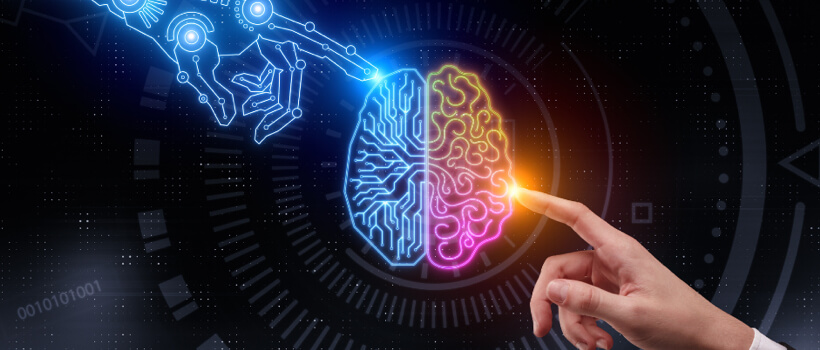 1-800-805-5783
1-800-805-5783 
Accurate diagnosis and prognosis of health conditions are a must for treatment, especially during the current pandemic, when we have to deal with many cases and related data. Analyzing this data effectively is the key to future diagnostics and prognostics. The massive health-related data piling up daily could be collected, processed, analyzed, segregated, and deciphered only with Artificial Intelligence. Without AI, understanding the overwhelming flow of accumulating health-related data would become next to impossible.
AI plays a critical role in diagnosing and managing various health conditions. AI predictions of certain chronic health conditions like cancer, genome diseases, post-pandemic health abnormalities, and even the impact of vaccines on future health dynamics are gaining momentum rapidly.
Cancer diagnosis with AI
Endocrine cancer Diagnosis:-
(According to the “Nature Reviews Endocrinology” abstract dated 09 November 2021)
Medical imaging interpretation is the key to diagnosing and analyzing tumorous masses in the endocrine system, like in any other organ malignancy-related diagnosis. Now, AI can be used to precisely understand the system-related tumor imaging data and analyze these images based on system-related inputs. This helps the doctor interpret the images as the patient’s treatment progresses. Based on AI inputs, doctors can make disease prognoses, and customized disease management plans for every case. Any minute abnormalities can also be detected with the help of AI image modeling as specific abnormal images, like the pituitary gland mass images, are very difficult for doctors to analyze. These images might not be very clear based on the location of the tumorous lesions. The endocrine cancer diagnosis was earlier dependent heavily on tissue culture and biopsy. A biopsy requires an invasive medical examination and can sometimes be very difficult, painful, and unreliable. Biopsy evaluations alone cannot be taken as confirmatory and determinant criteria for the prognosis of these types of cancers.
AI hence assists in non-invasive diagnosis of critically difficult cancers like endocrine cancers. AI predictions and pathological data studies can help the doctor analyze the patient’s condition and evaluate a befitting treatment process. The diagnosis of cancer is the key, and AI helps to assess logically any random abnormalities that can crop up due to the drugs and treatment procedures used. This could also be done by applying AI data interpretation models to study the data available in similar cases across different related neural networks. AI helps better coordinate the radiologists who evaluate this data and the doctors who treat the patients.

COVNet
(extract from the online published report of RSNA radiology. March 19, 2020)
The COVID-19 detection neural network, COVNet, is a deep learning model developed to analyze the mass CT scan images across different test hospitals. This was meant to analyze and decipher the chest CT scans across six hospitals between August 2016 and February 2022 to evaluate the extent of pneumonia acquired by the community because of contracting the COVID-19 SARS virus. The data was very useful in predicting pneumonia sensitivity depending on the patient’s age.
AI in thoracic surgery and diagnosis
AI in the diagnosis of lung cancer and thoracic surgery (based on the European respiratory review):

FIGURE 1 brief history of AI based on (the European respiratory review)
Thoracic surgeons across the globe are now able to comprehend the benefit of AI-assisted robotic surgery and the futuristic requirements for AI diagnosis in the treatment of lung cancer and other critical chronic lung-related ailments. The AI tool called CAD (computer-aided diagnostic tool) was designed and improvised to detect the presence of both benign and malignant chest nodules in its early stages of algorithm evolution. Later on, the CAD tool was developed to diagnose lung nodules with greater precision. This was done concurrently using AI with CT, MRI, and nuclear medicine data. A National Lung Screening trial was conducted in 2011 using AI diagnosis. Using this data, Ardila et al. created a neural network model to study low-volume CT data and predict futuristic risks. The data could predict people who are at risk of developing lung cancer in the future. 578 out of the 14,851 cases developed lung cancer the following year, which was confirmed with a biopsy. This model could beat the radiologist’s predictions by reducing the false positive predictions by 11% and the false negative percentage by 5%. The use of AI diagnosis will reduce complex diagnosis errors when it is used in concurrence with pulmonologist diagnosis.
Cost saving using AI diagnosis:
A study was conducted on rectal and colon polyps using AI diagnosis using the diagnostic tool in Tokyo, Japan, to predict the presence of neoplastic and non-neoplastic polyps detected in patients who underwent colonoscopy. AI diagnosis resulted in savings of US$119, US$52, US$34, and US$125 per colonoscopy, and up to US$149.2 million, US$12.4 million, US$1.1 million, and US$85.2 million for the gross annual reimbursement for colonoscopies conducted under public health insurances when the real-life case studies were conducted in the clinical studies of EndoBRAIN, Cybernet System Corp and Olympus Corp, Tokyo, Japan. According to this study using AI diagnosis, the cost of the average colonoscopy and the cost of the annual reimbursement on colonoscopies were reduced by 18.9% in Japan, 6.9% in England, 7.6% in Norway, and 10.9% in the USA, respectively.
Conclusion
The role of AI diagnosis is very crucial in the medical field today. It reduces the number of errors during diagnosis, contrary to the traditional diagnostic procedure, which relies heavily on radiological and pathological diagnosis alone. AI diagnosis has proven to reduce the cost of diagnosis and medical reimbursement. It is predicted that AI algorithms could be used to develop customized AI diagnostic tools that could further reduce the cost of diagnosis. The prognosis of disease utilizing this method is more accurate as AI diagnosis can detect abnormalities and make logical predictions as the disease progresses.
Tags: AI, artificial Intelligence, Healthcare